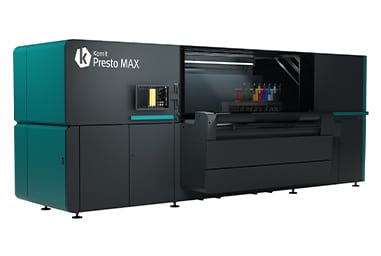The call to reduce waste and increase the sustainability of textiles is growing louder and is increasingly being enforced through legislation. Brand owners, designers and textile finishers are therefore increasingly focussing on upcycling to meet this demand. Unpopular materials should be put to innovative new uses and no longer end up in landfill sites.
There are a number of processes for colour digital printing on a wide variety of textiles. New, sustainable digital printing processes with a flexible, reliable technology in which materials are not pre-treated before finishing. According to the manufacturer, the available fabrics can be printed durably, uniformly, reliably and with high quality, without limiting the colour or graphic design options. According to many users who use these systems for finishing textiles, this technology has the advantage of being suitable for natural fibres, in contrast to sublimation printing, where the choice of fabrics is limited to white polyester.
According to the manufacturer, it is a one-step process that allows samples to be created quickly and easily, enabling designers to fulfil requirements with minimal time and cost. It can work with cotton, linen, denim, wool, polyester, blended fabrics and, in some cases, latex or leather.
Last year, for example, the British furniture designer Cozmo used on-demand digital printing to create sofa covers. In this way, even old furniture or home textiles can be given a new lease of life. These on-demand printed covers were presented at the London Design Festival and ITMA 2023 in Milan. Or the Israel-based company Cadena, which uses fast and flexible on-demand digital printing to provide many of its customers with customised textile finishes for a wide range of events. A special feature is that a so-called layering effect can be produced, which gives customised creations an additional dimension. A pigment-based ink set can be used to simulate 3D, embroidery and other graphic effects, including neon colours or lenticular images. Italian designer Fasac used this method to create a lace-like effect, which was presented at Première Vision in Paris earlier this year.
Fabric rolls, for example, which are no longer in keeping with contemporary tastes, used to be a sunk cost, whereas today new textures can be created for this material. Fabric or furniture manufacturers are able to print on old fabrics in stock and transform them into “new” fabrics and designs. A trend – away from more problematic, conventional practices in the textile industry – towards more sustainable practices. Because upcycling also means flexibility, versatility, adaptability and breaking away from the usual supply chains, unpredictable challenges and uncertainties.
Kornit
Kornit Digital (NASDAQ: KRNT) is a global market leader in sustainable, digital on-demand fashion and textile printing technologies. With complete solutions, including digital printing systems, inks and consumables and a global ecosystem for workflow and fulfilment management, the company is considered a pioneer for the fashion industry. Headquartered in Israel, Kornit Digital has offices in the US, Europe and Asia-Pacific and customers in more than 100 countries worldwide.


